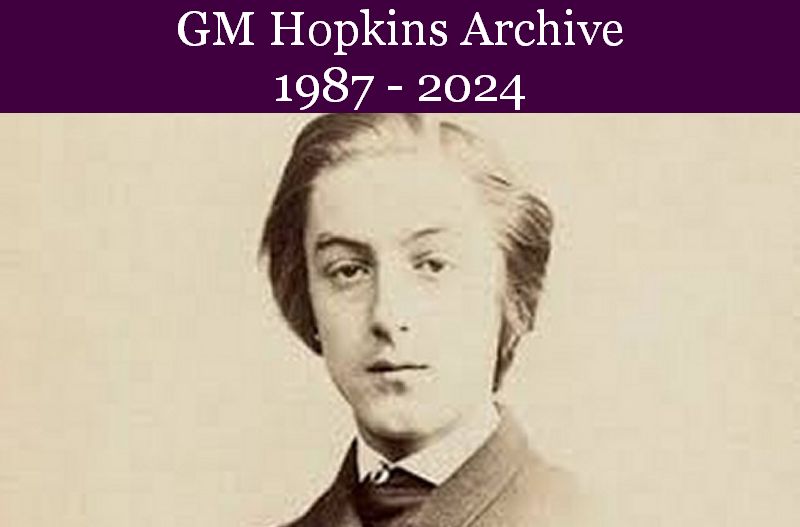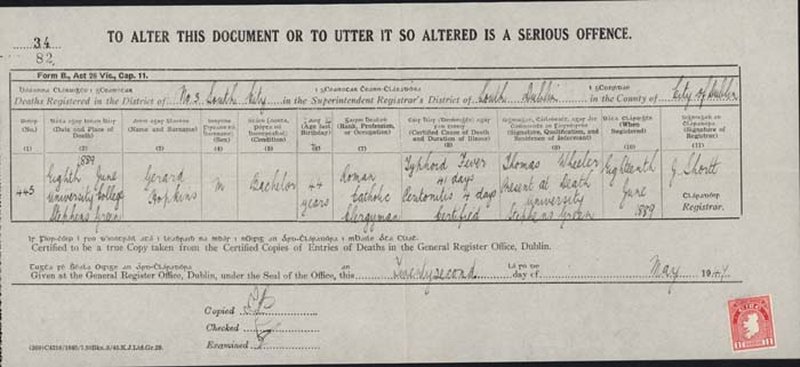Lightness: a new Perspective on Hopkins
Joseph J. Feeney, S.J.St. Joseph's,
Philadelphia, USA.
Gerard Manley Hopkins, known as a difficult poet writing of moral guilt,shipwrecks,death and martyrdom. Yet, Gerard Manley Hopkins' poetry can float with an airy lightness and a rarely noticed, playful quality.
Hopkins is famously known as a difficult poet, even a "heavy" poet, and in truth, he is heavy in content, heavy in style, and heavy in sound. The scholar James Milroy
, in his book The Language of Gerard Manley Hopkins , notes the poet's "dense verbal structure," and in print I've called his texture "granitic" and his density "hard as granite."
Today, by way of contrast, I consider a different side of Hopkins, a side much less noticed: his "lightness." I offer my comments in three parts:
- confirming Hopkins' heaviness,
- defining "lightness," and
- establishing Hopkins' lightness.
1. Hopkins' Heaviness
Gerard Hopkins
is, to be sure, heavy in content, heavy in style, and heavy in sound.
In content, he writes about moral guilt, shipwrecks and death, martyrdom (especially of women!), friends gone far away, the corruption of "our sordid turbid time,
" ecological destruction, the inevitability of sin, the sufferings of the Catholic Church, his own remoteness in Ireland, mental anguish, lost contact with God, feelings of despair, fear of lower-class rebellion, the humiliation of being human, and finally his loss of poetic inspiration. All this is, to be sure, very, very heavy.
A final note on Hopkins' hard content: it is often difficult to discover exactly what his words mean. Tubs of ink have been spilled over "The Windhover." To grasp its meaning, the last line of "The Wreck" has to be read backwards ("Our heart's charity's hearth's fire, our thoughts' chivalry's throng's Lord"). Hopkins had to write a prose summary to explain "Henry Purcell." The full meaning of "Tom's Garland" still eludes readers. Yes, his content is hard for the emotions and hard for the mind.
Hopkins is heavy in style, too - -magnificently heavy, but heavy nonetheless. He plays with words, linking them with hyphens, combining them into coinages, and twisting grammar, syntax, and typography. Hyphen-play begins in his first poem, "The Escorial," and later poems bring wonders like "white-f í ery and wh í rlwind-swivell è d sn ó w," "dappled-with-damson," "bl ó od-g ú sh bl á de-g á sh / Fl á me-r á sh," "T á tter-t á ngled and d í ngle-a-d á ngl è d," "dapple-d á wn-drawn," "day-labouring-out," "champ-white water-in-a-wallow," "With-a-fountain's shining-shot," and a late, muted "outward-steeled." His coinages, too, are flamboyant, frolicsome, but word-heavy: "dovewinged," "unchilding unfathering," "d á yspring," "wolfsnow," "mansex," "Goldengrove unleaving," "unforeseentimes," "Betweenpie," "fallowbootfellow," "waterblowballs," "downdolfinry." He twists syntax by omitting a needed "who" or a "which" ("O Hero savest," "Squander the hell-rook r á nks s á lly to molest him"). He makes taut but strange constructions like "Have f á ir f á llen." He twists typography in printing practices like "Christ,'s," "fell to the deck / (Crushed them) or water (and drowned them)," "king- / dom," "ling- / Ering!" "wrestling with (my God!) my God," and "smile / 'S not wrung." In style he is arguably one of the heaviest poets in the English language.
Hopkins' music, finally, is heavy in rhythm and sound. In "Binsey Poplars" the axe-blows against the trees pound with the heavy strokes of a woodsman or blacksmith: " Á ll f é lled, f é lled, are á ll f é lled." Some lines combine sounds and pitches in near-symphonic chords that rise in pitch: "The down-dugged ground-hugged grey / Hovers off, the jay-blue heavens appearing / Of pied and peeled May!" Or again, "a rack / Where selfwrung, selfstrung, sheathe- and shelterless, th ó ughts ag á inst thoughts í n groans gr í nd." The slow, solemn opening of "Spelt from Sibyl's Leaves" even has a musical rest written in its "score": "Earnest, earthless, equal, attuneable, vaulty, voluminous, . . . stupendous / Evening strains. . ."
How, one might well ask, can such a heavy poet ever be called "light"?
II. Defining "Lightness"
Yet for all its difficulty and heaviness, Hopkins' poetry can float with an airy lightness - -a rarely noticed, playful quality. Even his most serious poems — "The Wreck," the Terrible Sonnets, "Spelt from Sibyl's Leaves" — enjoy a lightness of whimsy and pun, of metaphor and wordplay, of rhythm and sound, balancing his heaviness, making his poems richer, more varied, and more human. Such "lightness" also places Hopkins in a tradition defined twenty years ago by the Italian novelist and critic Italo Calvino
(1923—1985).
In his posthumous Six Memos for the Next Millennium (1988), Calvino devotes his opening chapter to a literary quality he calls "lightness," affirming that "lightness" is one of the "values to be saved" in the literature of the new millennium —the 2000s. Working to define "lightness" through word and example, he first defines "lightness" as "the subtraction of weight," a way "to prevent the weight of matter from crushing us." Reflecting on Lucretius
's atoms and Ovid
's myths, he offers lightness as "a way of looking at the world based on philosophy and science" but "also arising from the writing itself, from the poet's own linguistic power."
In literature, he continues, lightness and weight are opposites, yet lightness can be appreciated only by knowing weight. Ultimately, Calvino desires "a lightening of language whereby meaning is conveyed through a verbal texture that seems weightless, until meaning itself takes on the same rarefied consistency. Subtlety and abstraction are also factors, along with "a visual image of lightness that acquires emblematic value, such as ... vaulting on nimble legs over a tombstone."
Calvino's examples of lightness range widely, from the Middle Ages to the present, and help clarify the word's meaning. In the medieval Decameron
, the poet Guido Cavalcanti
leaps over a tombstone as "a man very light in body," "the poet-philosopher who raises himself above the weight of the world, showing that with all his gravity he has the secret of lightness." In Romeo and Juliet , Mercutio enters with lightness and explains his philosophy through the airy dream of Queen Mab. In Hamlet , the Danish Prince mixes humor with melancholy. In As You Like It , Jacques describes melancholy as "a most humorous sadness"—"a veil," continues Calvino, "of minute particles of humours and sensations, a fine dust of atoms, like everything else that goes to make up the ultimate substance of the multiplicity of things." Later, Cyrano de Bergerac, in the context of a trip to the moon, whimsically proclaims the common brotherhood of men and cabbages.
Eighteenth-century writers imagine flying carpets, genies in lamps, the land of Laputa hovering in the air, and a baron carried aloft by ducks. For lightness, Leopardi looks to the night sky, and to "birds, the voice of a girl singing at a window, the clarity of the air - and, above all, the moon." With the help of such lightness, writes Calvino as he ends his essay, "we shall face the new millennium, without hoping to find anything more in it than what we ourselves are able to bring to it. Lightness, for example, whose virtues I have tried to illustrate here."
III. Hopkins' Lightness
Hopkins's lightness, to be sure, does not include Calvino's postmodernism or philosophical skepticism. But Calvino's essay situates Hopkins in a new tradition, and calls attention to his lightness. In poetry and prose, for example, Hopkins celebrates the "virtues" and images of lightness: air, birds, the moon, bluebells, violets, ashtrees, animal ears, a waterfall's misty rainbow, clouds, the wind, and the garden at St. Beuno'
s with "flights of steps seemingly up to heaven" - -or perhaps to "Plenlimmon, Conway Castle, or Salisbury Craig." He praises "the jay-blue heavens appearing / Of pied and peeled May," contemplates "The m ó on, dw í ndled and th í nned to the fr í nge of a f í ngernail h é ld to the c á ndle," offers a weightless rainbow in "The Caged Skylark," and presents a rapturous "beholder" whose heart "hurls for him, O half hurls earth for him off under his feet." He celebrates a woman who is "s ó light and fair," praises "fleece, fur, and feather," and devotes a long and lively poem to "The Blessed Virgin compared to the Air we Breathe."
Calvino's concept of "lightness" foregrounds Hopkins's play with birds and air and moons and misty rainbows. It reminds the reader how Hopkins loved to feel - -and did feel - the light softness of dogs' ears, cows' udders, moths' wings, a plush sloe, and a velvet peach. It recalls his whimsy and silliness and wit, his humor and breezy satire, his unexpected images, his mercurial metaphors, his peculiar perspectives, and the puns, hyphenates, and coinages of even his heaviest works. Most of all, Calvino's sense of "lightness" balances the received portrait of Hopkins as difficult and heavy, for playfulness lightens even his most serious work -- even "The Wreck of the Deutschland" and the Terrible Sonnets -- and relieves their heaviness. His lightness is able to "betwenpie" the peaks and mountains of his gloom, brightening a lovelier mile for both him and his readers. In Calvino's words, "with all his gravity he has the secret of lightness," and with its help was able "to prevent the weight of matter from crushing us." Perhaps above all, in "The Caged Skylark," the lightness of a rainbow points to the ultimate lightness or weightlessness of bodily resurrection: "meadow-d ó wn is n ó t distr é ssed / For a r á inbow f ó oting it nor h é for his b ó nes r í sen." The images and the metaphor are as light as a breeze: just as the soft grass on a rolling meadow is not burdened when touched by the base of a rainbow, so a man's risen bones are unburdened by -- freed from - -the heaviness of his old body. It's a magical metaphor, as is the metaphor for the Virgin Mary who is as light and lifegiving as air: "men are meant to share / Her life as life does air."
I end with a light poem from Hopkins' beloved North Wales which floats like its own bird in flight. In it a soaring woodlark, with just "so tiny a trickle of song-strain," looks down at soft fields of flowers and cereal-grass. As you listen, be sure to hear the poem's light, playful music:
"... the c ó rn is c ó rded and sh ó ulders its sheaf,
The ear in milk, lush the sash,
And cr ú sh-s í lk p ó ppies afl á sh,
The bl ó od-g ú sh bl á de-g á sh
Fl á me-r á sh r ú dr é d
B ú d sh é lling or br ó ad-sh é d
T á tter-t á ngled and d í ngle-a-d á ngl è d
D á ndy-h ú ng d á inty h éa d..."
The airy woodlark is so delighted that he tweets, "I á m so v é ry, o s ó very gl á d," as he flies back to his nest
"With a sweet joy of a sweet joy,
Sweet, of a sweet, of a sweet joy
Of a sweet - -a sweet - -sweet - -joy.
Line by line the poem itself floats, finally floating away. So does Hopkins at his lightest.
And so should I.
* This essay is adapted from my forthcoming book The Playfulness of Gerard Manley Hopkins, and appears with the kind permission of the publisher, Ashgate (JF)
Links to Hopkins Literary Festival 2007
Elizabeth Bishop and Hopkins Poetry
Aubrey de Vere and Gerard Manley Hopkins
Patrick Kavanagh and Gerard Manley Hopkins
Communion of Saints in Hopkins Poetry
Place of Church in Hopkins Juvenile Poems

